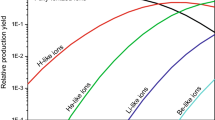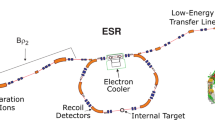Abstract
Ion storage rings and ion traps provide the very first opportunity to address nuclear beta decay under conditions prevailing in hot stellar plasmas during nucleosynthesis, i.e. at high atomic charge states. Experiments are summarized that were performed in this field during the last decade at the ion storage-cooler ring ESR in Darmstadt. Special emphasis is given to the first observation of bound-state beta decay, where the created electron remains bound in an inner orbital of the daughter atom. The impact of this specific ‘stellar’ decay mode for s-process nucleosynthesis as well as for nuclear ‘eon clocks’ is outlined. Finally, a new technique, single-ion decay spectroscopy, is presented, where one observes two-body beta decay characteristics (i.e. orbital electron capture or bound-state beta decay) of highly charged, single ions for well-defined nuclear and atomic quantum states of both the mother – and the daughter – ion.
Similar content being viewed by others
References
Jung, M., et al.: First observation of bound-state β decay. Phys. Rev. Lett. 69, 2164 (1992)
Bosch, F., et al.: Observation of bound-state β decay of fully ionized 187Re: 187Re - 187Os cosmochronometry. Phys. Rev. Lett. 77, 5190 (1996)
Ohtsubo, T., et al.: Simultaneous measurement of β decay to bound and continuum electron states. Phys. Rev. Lett. 95, 52501 (2005)
Takahashi, K., Yokoi, K.: Beta-decay rates of highly ionized atoms in stellar interiors. At. Data Nucl. Data Tables 26, 375 (1987)
Perlmutter, S., et al.: Measurements of Ω and Λ from 42 High-Redshift Supernovae. Astrophys. J. 571, 561 (1999)
Krauss, L.M., Charboyer, B.: Age estimates of Globular Clusters in the Milky Way: Constraints on cosmology. Science 299, 65 (2003)
Anders, E., et al.: Setting a cosmic clock with highly charged ions. Geochim. Cosmochim. Acta 53, 197 (1989)
Symbalisty, E.M.D., Schramm, D.N.: Nucleocosmochronology. Rep. Prog. Phys. 44, 293 (1981)
Takahashi, K., Yokoi, K.: Nuclear β decays of highly ionized heavy atoms in stellar interiors. Nucl. Phys. A404, 578 (1983)
Takahashi, K., Yokoi, K.: Bound-state beta decay of highly ionized atoms. Phys. Rev. C36, 1522 (1987)
Takahashi, K.: The 187Re - 187Os cosmochronometry: Latest developments. In: Tours Symposium on Nuclear Physics III, AIP Conf. Proc, p. 616 (1997)
Behrens, H., Jaenecke, J.: Numerical tables for beta-decay and electron capture. In: Landolt-Börnstein, New Series GG1, vol. 4 (2001)
Author information
Authors and Affiliations
Consortia
Corresponding author
Rights and permissions
About this article
Cite this article
Bosch, F., for the FRS/ESR Mass – and Lifetime – Collaboration. Beta decay of highly charged ions. Hyperfine Interact 173, 1–11 (2006). https://doi.org/10.1007/s10751-007-9535-2
Published:
Issue Date:
DOI: https://doi.org/10.1007/s10751-007-9535-2




